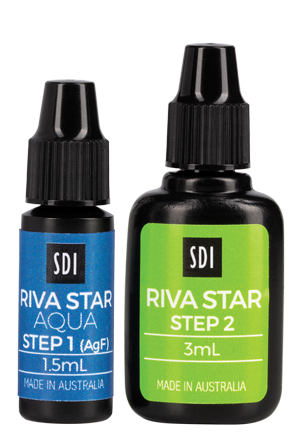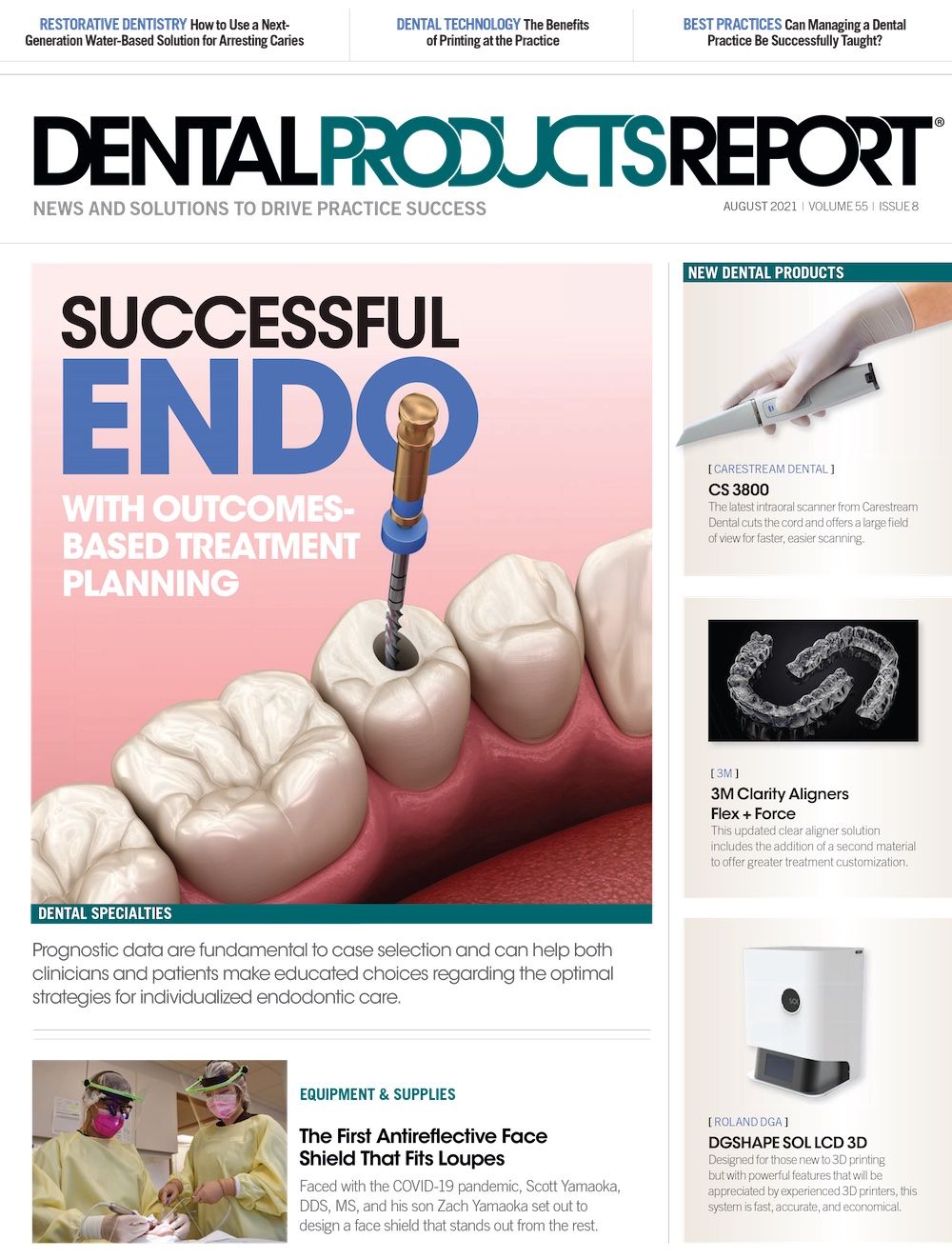Untreated decay in the teeth of young children remains a challenge for public health, from both an oral health and a social perspective.
Decay causes a significant strain on the teeth, which can lead to pain or even infection. The problem is more prevalent among low-income families than those with higher incomes. Silver diamine fluoride (SDF) procedures have been shown to arrest carious lesions 70% of the time, which is an advantage for many patients.1
Riva Star Aqua
This 2-step silver fluoride solution system is designed to desensitize tooth pain. It is formulated to block dentin tubules and provide sensitivity relief to patients. The system’s potassium iodide formula reduces staining. It can be used without a gingival barrier.
SDI
800-228-5166 | sdi.com.au
The benefits of topical fluoride applications are well known for reducing tooth decay in children. When tooth structure becomes demineralized, the fluoride ion can take the place of a hydroxyl ion within the tooth. This makes the tooth structure less likely to demineralize in an acidic environment.2 Both the silver and the fluoride together make the product beneficial when treating decay.
Riva Star Aqua is a next-generation water-based silver fluoride solution, with additional patient benefits. Similar to Riva Star (SDF), Riva Star Aqua is also a noninvasive 2-step patented system used to desensitize tooth pain in a few drops. The product does not have an ammonia base and has been developed to eliminate smell, unpleasant taste, and burning when touching gingival tissues.3
Riva Star Aqua’s first step involves silver fluoride, which is different from other silver diamine fluoride products on the market. Although the product has no ammonia components, the silver and fluoride can work in the same manner as the original Riva Star. Silver ions have been demonstrated to inhibit bacteria by altering hydrogen bonding, inhibiting the respiratory process, unraveling DNA, and disrupting cellular division and cell wall synthesis.4
One drawback of silver products is their potential to stain demineralized tooth structure brown or black. This can make for a successful clinical outcome but an unfavorable esthetic outcome. Both Riva Star and Riva Star Aqua contain potassium iodide in the second step. When used correctly, the potassium iodide reduces staining by forming a silver iodide precipitate, which reduces the amount of staining caused by silver products. This can leave patients with both a favorable esthetic and clinical outcome.5
Efficacy of Silver Fluoride Compared With Silver Diamine Fluoride
The pH of Riva Star Aqua is significantly lower than that of Riva Star, which has a pH of 11. The pH is closer to the physiological pH of 7.4, making it more compatible for use in the oral environment.6
SDF has been demonstrated to have a caries arrest rate of 68% to 87.7% 2 years after application.7
According to results from 1 study, silver fluoride alone had arrest rates comparable to SDF. By also using potassium iodide, a more esthetic outcome was achieved; however, arrest rates were slightly lower, so more frequent applications may be necessary. Subsequent applications can be done as part of a caries management program using active surveillance at recalls.5
The Silver Modified Atraumatic Restorative Treatment (SMART) Technique for Indirect Pulp Therapy in Permanent Teeth
A 6-year-old boy presented for a routine examination. The child had a history of decay in his primary dentition and active decay in the permanent dentition and was classified with a high caries risk. The clinical examination revealed carious lesions on teeth #19 and #30. A radiographic examination showed lesions approximately two-thirds into the dentin. Due to the size of the lesions and their proximity to the pulp, indirect pulp therapy (incomplete caries removal) was performed. After the dentin enamel junction was free of decay and demineralization, the tooth was etched with phosphoric acid and prepared for Riva Star Aqua. Step 1 was applied for 60 seconds. Immediately after, Step 2 was applied for 90 seconds. The tooth was rinsed and dried and restored with Riva Self Cure HV, a glass ionomer from SDI. The postoperative evaluation showed an esthetic outcome free of black discoloration and staining.
In conclusion, Riva Star Aqua is as effective in arresting carious lesions as an SDF solution.
Criteria for Indirect Pulp Capping in Permanent Teeth8
- Deep carious lesion
- No swelling/sinus tract/mobility
- No spontaneous pain or history of spontaneous pain
- Positive to vitality testing
- No apical pathosis
- Apical lesion
- Widened periodontal ligament
- No calcifications
Technique
- Local anesthesia
- Rubber dam isolation
- Caries removal (dentin-enamel junction must be free of demineralization and decay)
- Avoid pulpal exposure
- Acid etch
- Riva Star Aqua Step 1 (60 seconds) (American Academy of Pediatric Dentistry, 2017)
- Riva Star Aqua Step 2 (90 seconds minimum)
- Rinse and dry
- Riva SC HV
- Final restoration
References
- American Academy of Pediatric Dentistry. Policy on the use of silver diamine fluoride for pediatric dental patients. In: The Reference Manual of Pediatric Dentistry, 2020-2021. American Academy of Pediatric Dentistry; 2021:66-69. Accessed June 10, 2021. https://www.aapd.org/research/oral-health-policies--recommendations/use-of-silver-diamine-fluoride-for-pediatric-dental-patients/
- ten Cate JM. Current concepts on the theories of the mechanism of action of fluoride. Acta Odontol Scand. 1999;57(6):325-329. doi:10.1080/000163599428562
- Riva Star Aqua: the next generation SDF system. SDI. Accessed June 10, 2021. https://www.sdi.com.au/pdfs/brochures/en-us/riva%20star%20aqua_sdi_brochures_en-us.pdf
- Rosenblatt A, Stamford TCM, Niederman R. Silver diamine fluoride: a caries “silver-fluoride bullet.” J Dent Res. 2009;88(2):116-125. doi:10.1177/0022034508329406
- Turton B, Horn R, Durward C. Caries arrest and lesion appearance using two different silver fluoride therapies on primary teeth with and without potassium iodide: 12-month results. Clin Exp Dent Res. Published online December 28, 2020. doi:10.1002/cre2.367
- Riva Star, Riva Star Aqua: the next generation SDF system. SDI. Accessed June 10, 2021. https://www.sdi.com.au/pdfs/brochures/au/riva%20star%20aqua_sdi_brochures_au.pdf
- Crystal YO, Marghalani AA, Ureles SD, et al. Use of silver diamine fluoride for dental caries management in children and adolescents, including those with special health care needs. Pediatr Dent. 2017;39(5):135-145.
- Orhan AI, Oz FT, Orhan K. Pulp exposure occurrence and outcomes after 1- or 2-visit indirect pulp therapy vs complete caries removal in primary and permanent molars. Pediatr Dent. 2010;32(4):347-355.

